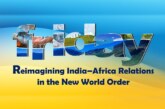This ambitious itinerary was not merely an exercise in geographic outreach, but a strategic expression of India’s commitment to shaping an inclusive, multipolar order, one that transcends traditional axes of influence. Each stop on this journey reflected India’s intent to reconnect with postcolonial partners whose aspirations and challenges resonate with its own developmental journey. By traversing three continents, the tour affirmed New Delhi’s resolve to consolidate leadership among emerging economies, carve out new geo-economic corridors, and infuse diplomacy with the ethos of solidarity and shared progress.
Shweta Tyagi*
Hon’ble Prime Minister Narendra Modi’s week-long diplomatic sojourn from July 2 to July 9, 2025 spanning Ghana, Trinidad & Tobago, Argentina, Brazil, and Namibia, signalled a purposeful recalibration of India’s external engagement with the Global South and the broader Atlantic world. As PM Modi stated in his departure remarks, “I am confident that my visits to the five countries will reinforce our bonds of friendship across the Global South, strengthen our partnerships on both sides of the Atlantic, and deepen engagements in multilateral platforms such as BRICS, the African Union, ECOWAS and the CARICOM”.
The Global South is a loosely defined group of countries mostly in Africa, Asia, and Latin America connected more by shared postcolonial trajectories and economic aspirations than by formal institutional alignment. India has long positioned itself as a champion of this group, especially since the Voice of the Global South Summit it hosted in 2023. However, transitioning from aspirational leadership to delivering tangible outcomes remains a formidable challenge.
This ambitious itinerary was not merely an exercise in geographic outreach, but a strategic expression of India’s commitment to shaping an inclusive, multipolar order, one that transcends traditional axes of influence. Each stop on this journey reflected India’s intent to reconnect with postcolonial partners whose aspirations and challenges resonate with its own developmental journey. By traversing three continents, the tour affirmed New Delhi’s resolve to consolidate leadership among emerging economies, carve out new geo-economic corridors, and infuse diplomacy with the ethos of solidarity and shared progress.
A Journey of Convergence
Ghana marked the inaugural chapter of this Atlantic odyssey, both an acknowledgment of shared postcolonial legacies and a catalytic moment in what has long been an underexplored bilateral relationship. The visit, the first by an Indian prime minister in three decades, blended symbolism with substance. Addressing the Ghanaian Parliament, Prime Minister Modi emphasized, “The relationship between India and Ghana knows no bounds… The friendship between the two nations is sweeter than Ghana’s famous ‘Sugar Loaf Pineapple’.” He also described India as the mother of democracy, stressing, “For India, democracy is not just a system, it is a part of our fundamental values.” Reflecting the depth of mutual regard, President John Dramani Mahama remarked, “India is our mirror in the East, a partner in progress, a friend in solidarity. This visit writes a new chapter in Ghana-India ties.” From the ceremonial bestowal of Ghana’s highest civilian honour to the unveiling of a “comprehensive partnership,” the engagement aimed to reset the economic and diplomatic axis between New Delhi and Accra. Discussions spanned trade, digital technologies, energy, and defense, with a notable commitment to doubling bilateral trade from $3 billion to $6 billion within five years. The visit invoked a spirit of historical solidarity, highlighting India’s support during Ghana’s independence movement and the mutual affinities forged through the Non-Aligned Movement. The focus on digital inclusivity, skills development, and healthcare underscored a vision of cooperation rooted in memory yet oriented toward a shared future.
From Ghana, the momentum shifted to Trinidad & Tobago, where emotional resonance and strategic depth converged. Modi’s arrival, the first Indian bilateral visit since 1999 coincided with the 180th anniversary of Indian arrival in the Caribbean. This commemoration added a powerful cultural dimension to the visit, foregrounding narratives of indentured migration and diaspora resilience. The Indo-Trinidadian community, now a vibrant pillar of national life, served as both a bridge and a foundation for renewed cooperation. Beyond cultural ties, high-level dialogues with President Christine Kangaloo and Prime Minister Keith Rowley focused on trade diversification, healthcare, education, and technology. Modi’s landmark address to the Joint Session of Parliament underscored a vision of partnership rooted in democratic development and innovation. “Our destinies are intertwined by history, shaped by democracy, and driven by the dreams of our young people,” he declared. Echoing this sentiment, Prime Minister Kamla Persad-Bissessar affirmed, “We do not see India as just a distant friend. India now stands beside us, as a pillar of hope and shared potential in the Global South.” This blend of emotional connection and forward-looking collaboration framed India as both ancestral homeland and contemporary partner, a dual identity that deepens its appeal and influence across the Atlantic.
In Argentina, the tour assumed a tone of pragmatic optimism. Modi’s visit ending a nearly six-decade absence of Indian prime ministerial presence was rich in symbolism yet firmly focused on the future. Bilateral talks with President Javier Milei centred on agriculture, food processing, and agri-tech areas of mutual strength and potential collaboration. Equally important was the dialogue on energy, with discussions on renewables and hydrocarbons positioning Argentina as a strategic node in India’s energy security architecture. Lithium emerged as a key area of convergence, aligning Argentina’s mineral wealth with India’s clean technology ambitions. As Argentina’s role in the G20 grows, so too does the relevance of a partnership anchored in multilateralism, innovation, and economic resilience. Modi’s Argentine engagement reflected a matured, multidimensional approach to South-South cooperation, one that is both visionary and grounded in complementary strengths.
Brazil offered a compelling fusion of bilateral ambition and multilateral leadership, as Modi’s visit coincided with India’s participation in the 17th BRICS Summit in Rio de Janeiro. His meetings with President Luiz Inácio Lula da Silva explored deeper cooperation in trade, clean energy, defense, and space research. However, it was on the BRICS stage that India’s strategic posture came into full view. Modi advocated for reforms in global governance, responsible AI, climate cooperation, and digital democratization positioning India as both a trusted bilateral partner and a vocal champion of multilateral transformation. The Brazil leg exemplified how India’s foreign policy now navigates seamlessly between national interest and global stewardship, reinforcing its role as a principled architect of the twenty-first-century order.
Concluding in Namibia, the tour came full circle, returning to Africa with a renewed focus on historical kinship and future-oriented development. Delhi’s first visit to the country in 27 years was infused with symbolism, including a well-received address to the Namibian Parliament that honoured shared struggles against colonialism. Yet, the emphasis was decidedly practical: agreements on defense, digital technology, health, and economic empowerment signaled a robust deepening of ties. Noteworthy milestones included the establishment of an Entrepreneurship Development Centre, health cooperation, and Namibia’s adoption of India’s Unified Payments Interface (UPI) making it the first African nation to do so. This digital leap signalled India’s strategic intent to offer inclusive, scalable technologies as instruments of transformation. Defense cooperation, scholarships, IT capacity-building, and trade surpassing $800 million were also part of the evolving India-Namibia matrix. Namibia’s alignment with Indian-led initiatives like the International Solar Alliance and the Global Biofuels Alliance further testified to converging visions around sustainability and innovation.
Counterweights and Coalitions
The broader implications of this five-nation tour transcend individual bilateral gains. Strategically, it positioned India as a “Voice of the Global South,” advancing a cohesive narrative of inclusive growth, equitable technology access, and South-South solidarity. Modi’s engagements reinforced a vision of global order built on mutual respect, institutional reform, and the redistribution of globalization’s dividends an aspiration long side-lined in Western-dominated forums.
India’s multilateral outreach was equally deliberate. By engaging key groupings such as BRICS, the African Union, CARICOM, and ECOWAS, India sought to embed itself in emerging regional architectures and forge alternative global governance pathways. These coalitions offer a platform for addressing climate justice, health equity, and digital transformation domains where traditional powers often prioritize parochial interests. India’s approach was not only to expand influence but to architect durable frameworks responsive to the realities of the Global South.
This recalibrated diplomacy also served as a strategic counterweight to the expanding footprints of China and the European Union. While China’s Belt and Road Initiative and the EU’s Global Gateway reshape infrastructure and trade paradigms, India’s model emphasizes empowerment through digital public goods, transparent partnerships, and democratic accountability. Its offerings, ranging from affordable healthcare to entrepreneurship and inclusive fintech position India as a trusted, values-driven partner rather than a transactional actor.
Yet, the tour revealed enduring dilemmas facing aspirational powers. Translating symbolic diplomacy into sustained geopolitical capital demands more than announcements and handshakes. Real success hinges on implementation, ensuring agreements lead to tangible investments, technology flows, and resilient infrastructure. Historical precedent warns of gaps between promise and delivery, often marred by bureaucratic inertia, institutional asymmetries, and shifting domestic contexts in partner states. The challenges of regulatory complexity, investor confidence, and capacity constraints remain formidable.
Anchoring Intent with Action
Sustaining momentum will require India to institutionalize its engagements through follow-up missions, embedded economic diplomacy units, and permanent developmental presence. Success will also rest on India’s readiness to commit resources: concessional finance, capacity-building, and risk mitigation tools for Indian businesses abroad. Crucially, India must guard against strategic overreach, ensuring that ambitions remain grounded in deliverable outcomes. Its credibility will be tested not by declarations but by actions especially in light of persistent competition from other global powers.
From a long-term perspective, this tour could mark a transformative moment in Indian foreign policy. If nurtured with consistency and commitment, India may move from symbolic leadership to becoming an indispensable partner in shaping global norms, economic ecosystems, and developmental trajectories. The road ahead will demand incremental gains measured by grassroots impact, cross-regional networks, and resilient South-South partnerships.
Conclusion
The 2025 tour stands as a milestone in Indian diplomacy affirming intent, showcasing leadership, and opening new corridors of cooperation. Its ultimate legacy will rest not in the grandeur of ceremonies but in the lived outcomes of people and institutions touched by its promises. To truly anchor its leadership in the Global South, India must match high-level engagement with grounded action, adapt swiftly to global flux, and sustain relationships with the resolve to convert vision into lasting transformation.
*Associate Editor, Focus Global Reporter








